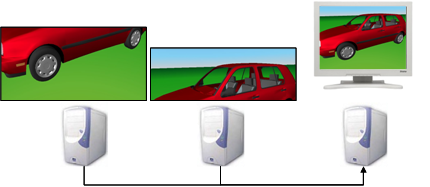Cluster Basics and Load Balancing
Keywords:
tutorial,
X3D,
world,
engine,
distribution,
cluster
Author(s): Marcus Roth,
Patrick Riess
Date: 2007-11-28
Summary: This tutorial gives an overview over cluster topologies in computer graphics. It continues with the often ignored topic of load balancing, as clusters are mostly used to setup multi display environments without a real distribution of load. In InstantReality the activation of load balancing is very easy. You will finally get a basic introduction on how to setup your network and start cluster servers to be ready to use your cluster. Different setups will be explained in the following tutorials of this Clustering section.
Preconditions for this tutorial
There are no preconditions.
Topologies
To get expensive computations faster, a common approach nowadays is establishing a cluster of more or less convenient hardware, let's say PCs. In computer graphics we can imagine several configurations using a cluster of PCs as you can see in following scenarios.
Most common systems look like the illustration below, several PCs are connected over a network to render and display a virtual scene together on multiple displays. The advantage is a high resolution but as one PC is responsible for exactly one display the system is only as fast as the PC which has the highest render load.

To render complex geometries a configuration shown below is possible. The scene has to be distributed to PCs in a cluster, they compute their task and send the results back to the PC which composes and displays the final image. In this case we use a cluster to render complex scenes but we lose the high resolution of a multi display system.

If we like to benefit of both advantages, i.e. high resolution and effective rendering of complex models, we need a flexible system. In this system we have several PCs in a network where some are playing a role as display and others that are not. This topology can also be used as stereo setup for instance.

The InstantReality system provides the concept of using an arbitrary number of displays in a specified alignment together with an arbitrary number of PCs. Those can be connected to a display or not. This flexible concept allows each of the above basic setups. But it can also be used to create more complex configurations like cave environments with displays which are orthogonal to each other or even displays in an arbitrary angle. To see how simple a cluster is configured please read the following tutorials in the Clustering section. But you should finish this one for load balancing aspects and basic IR cluster setup information.
Load balancing
In a cluster, PCs should share the overall load equally between each other to be effective and to get the best performance. In computer graphics all of them generate an equally cost intensive part of the scene. A proper and fast precomputation of the scene takes place before distributing parts of it to the PCs. Finally every rendered section which belongs to another display PC is copied over the network to its target. This approach offers arbitrary setups like single display and multi display systems, both as mono or stereo solution with an effective balancing of the upcoming load.
There are several approaches to balance the load of 3D scenes. Two big categories are image space distribution and geometry distribution.
Image space balancing (Sort-First)
In image space distributed balancing, also called Sort-First, a precomputation takes place which transforms only bounding boxes of objects into camera space to get the approximate position of geometries on the displays. By this information a cost function is estimated. This is based on transformation costs as well as the rasterization costs and therefore takes the number of vertices and size of rendered bounding boxes into account.
Now that each PC has it's estimated costs, parts of viewports are distributed to render on another PC which has only low costs. The resulting rendered parts are sent back to the display PC over network. If you want to learn more about the implemented cost estimation and load balancing algorithms, please check the Technical Details section at the end of this tutorial.

Geometry based balancing (Sort-Last)
In this kind of load balancing, parts of the scenegraph are distributed. That means geometries are distributed between PCs and after rendering the pixel data including the depth information is copied back to the display PC. On the display PC all received images are composed to one image again by involving the depth. This approach shouldn't be used on multi display systems for one reason. Geometries can be bigger than a single display resolution, so it can't be rendered by only one graphics card as it doesn't fit to the framebuffer. But on a single display cluster system it is very fast and a better choice than Sort-First.

Important: To use load balancing effectively it is very important to have 1000Mbit network, because pixel data has to be sent over network. Otherwise you won't have the advantages of load balancing.
Network configuration
Setup your network. Each host must be reachable by name from each other host. Try this with ping host. If you have a local network (no access to the internet), you have to define a dummy gateway eg. 192.168.1.254 if your network uses the IP-Range 192.168.1.0 - 192.168.1.253. On Linux, if your /etc/hosts file contains a line like 127.0.0.1 myHostname where myHostname is not localhost, then remove this line.
InstantPlayer and InstantCluster
Doing cluster rendering with the InstantReality framework you have one instance of the InstantPlayer running your X3D application. This application provides the user interface, loads the x3d file including the engine configuration and does all the simulation for your scene. To be able to produce a graphics output on another host, you have to run an InstantCluster on this host. Start the "InstantCluster" entry in your menu or application directory or use an autostart mechanism to run it all the time. It only needs resources while rendering and otherwise sleeps and waits for connections.
Technical Details
For technical details about the algorithms of the load balancing and some benchmarks I suggest to have a look into the paper Load Balancing on Cluster-Based Multi Projector Display Systems.
With sort-first approach, i.e. image space based distribution, we got a speedup of 3 to 6 for a single display setup and 16 PCs in a cluster. On multi display systems with 48 PCs (24 PCs for displaying in 6 x 4 alignment) animations were 3 to 4 times faster.
Sort-last balancing with a model of Standford's David Statue and 56 millions of polygons achieved a speedup of 10 with 16 PCs in the cluster and even over 20 with more than 32 PCs. For the composition of image parts it uses a new pipeline approach.
Comments
This tutorial has no comments.
Add a new comment
Due to excessive spamming we have disabled the comment functionality for tutorials. Please use our forum to post any questions.